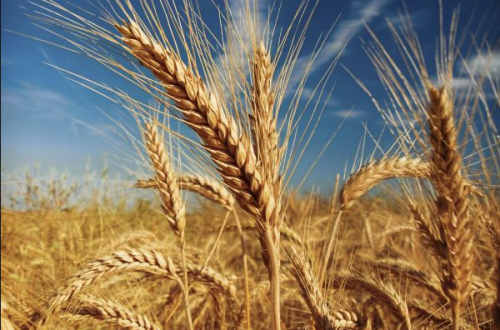
Linen
Linen (Linʹen) is a white textile material or cloth produced from yarn made from the fibers of the flax plant whose growth is described in the Old Covenant book of the Exodus.
(Now the flax and the barley were struck by the hail, for the barley had ripened and the flax was in bud. But the wheat and the spelt were not struck, for they are later crops.) (Exodus 9:31,32 NET)
Description
It was one of the earliest known textile materials. (3)(4) The great center of the linen manufacture of antiquity was Egypt, and in connection with that country, we find the first allusion to it in Scripture (Genesis 41:42). (16)
Then Pharaoh took his signet ring from his own hand and put it on Joseph’s. He clothed him with fine linen clothes and put a gold chain around his neck. (Genesis 41:42 NET)
It was much valued and used in ancient times (Leviticus 13:47) as it is in modern times. (12)
It was bleached before being woven into clothing, bedding, curtains, and burial shrouds. (7) The word “linen” is also used to describe clothes or garments made from this cloth. (2) It was characterized by its unique white color and served many purposes in the ancient world. (3) Furthermore, the Hebrew word meaning “whiteness” also is used to represent linen, because bleached linen was so white. (2) Along with wool, linen was one of the only fibers readily available for the production of cloth in the ancient world. Linen production likely originated in ancient Near Eastern contexts. (3)
Flax appears to have been the first vegetable fiber cultivated by early agriculturalists. Flax was also cultivated for its seeds, called linseeds, which contain oil and protein. Flax plants require a great amount of moisture and thus are best suited to areas with fertile clay, rich in silt, as in Egypt, where they grew abundantly. Elsewhere in dryer climates irrigation was necessary for cultivation. (5)
Consequently, the great cultivator and exporter of flax was Egypt. In Proverbs 7:16 we read of Egyptian linen (cf. Heb. ḥaṭuḇôt, ‘many coloured’). Red linen was especially precious in ancient Egypt and was called “royal linen.” It is quite probable that linen (cf. Egyptian words sś and ’idmy as possible loan-words in Hebrew and Canaanite) was imported from Egypt by the inhabitants of Israel from the earliest times. We know from Egyptian documents that linen was exported from Egypt to Phoenicia (cf. also Ezekiel 27:7) and especially Byblos through many centuries. (8)
Production
Flax is a winter annual plant with slender long stems (Linum usitatissimum L.; Heb. pištâ). It has a yellowish, thin stalk that grows up to three feet tall and produces vivid blue flowers. (3) Flax requires a great amount of moisture and thus is best suited to areas with fertile silty clays as in Egypt, where it grew abundantly. Elsewhere in dryer climates irrigation was necessary for cultivation. (10) The stem of the flax plant produces fibers for weaving into linen fabrics, while its seeds, called linseeds, produce linseed oil that can be used for eating and for lamp oil. However, the best fibers for spinning into linen are those that are harvested before the plant produces seed heads. (9) Ancient peoples cultivated this valuable crop for both its stalk and seeds. (3) Flax was never extensively grown in Israel in biblical times. However, according to Exodus 9:31; Hosea 2:5 and probably Joshua 2:6, it was cultivated from early times. (8)
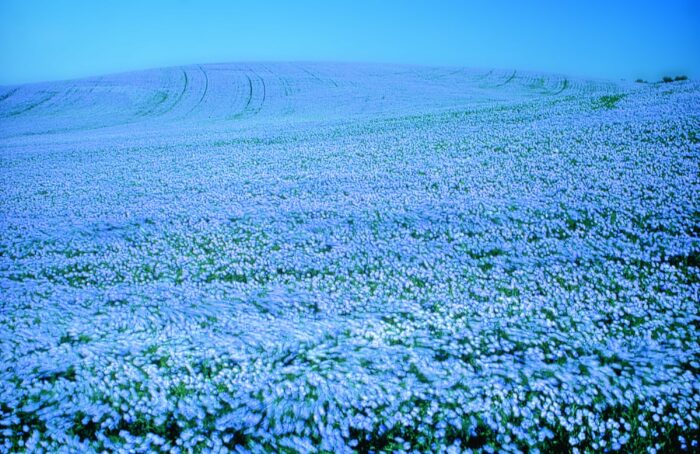
Israel had craftsmen skilled in weaving fine linen, although the craft probably was first learned in Egypt (Exodus 35:35; 38:23). Guilds of linen weavers also existed in Bible times (1 Chronicles 4:21). Israelite weavers were so skilled that their fine linen was often preferred to that produced in Egypt. (2)
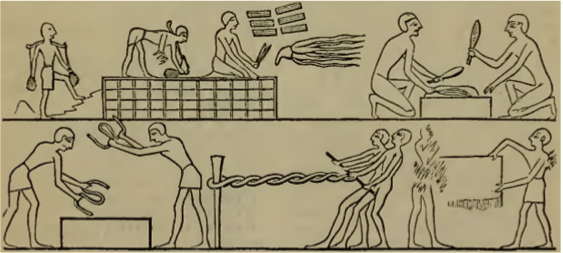
The Bible does not contain a description of the steps in linen production, but the Gezer Calendar (ca 10th or 9th cent. b.c.) refers to March as the month of the agricultural year in which flax is pulled. (4) When the stalks (Heb. pištê hāʿēṣ) are about half a meter (2 ft) tall, they are pulled up, allowed to dry for a time in the field, then cleaned for several weeks. (4) In Egypt the next step to produce fine was by soaking or steeping the flax in water to loosen, dissolve, and rot away layers, facilitating the separation of fine fibers from the woody stem; a cleaning process called retting. (5)(3) The fibers are then bleached and allowed to dry again for a much longer period – about two years. (4) It is probably the second, longer drying period after the “retting” that is mentioned in the story of Rahab hiding the twelve Israelite spies (Joshua 2:6). Once cleaned and dried, the stems were beaten (scrutched), scraped, and combed into strands (hackled or heckled) to remove the outer covering and pulp leaving the long wavy hanks or stricks of linen fiber that at times were nearly invisible. (5)(4) After the flax fibers are cleaned and combed, they are sent to the spinner to be spun into thread. In biblical times this was done with a drop-weighted spindle. (4)(5)(9) Among the Hebrews, as apparently among the Canaanites, the spinning and weaving of linen were carried on by the women (Proverbs 31:13,19,24), among whom skill in this work was considered highly praiseworthy (Exodus 35:25). One family, the house of Ashbea, attained eminence as workers in linen (1 Chronicles 4:21; 2 Chronicles 2:14). (11) The spun thread is woven into cloth, which can then be draped or sewn into Garments. (4)(5)(9)
The linen fabrics are strong and smooth. Linen bleaches easily but does not dye as well as silk, cotton, or wool and unless specially treated is more likely to fade. Hence linen is usually white or cream colored. Linen fabrics are traditionally likely to wrinkle and crease. Modern finishes, however, have been developed to make it crush resistant, increasing its popularity for clothing. (14) Along with wool, linen was the primary fabric mentioned in the Bible. (9)
“Fine twined linen” was prescribed for the Temple veil in the Old Testament of the Bible, and fine linen is still a luxury. Lustrous table damask of linen rivals silk brocade in beauty. Snowy-white bleached linen, with its fine smooth surface, is the preferred material for handkerchiefs and embroidery fabrics. Since linen is an excellent conductor of heat, clothing made of it is cool for summer. Linen towels are considered preferable to cotton, for they absorb moisture more readily. Linen’s great tensile strength makes it desirable for sailcloth and the most delicate handmade laces. Heirlooms of lace and table linen, as well as Egyptian mummy cloths, attest to the durability of linen. (14) In addition, Lamp wicks were made of flax (Isaiah 42:3; Matthew 12:20). The use of flax for wicks is referred to by Isaiah. When describing the tenderness and love of the Saviour, he says,
A crushed reed he will not break, a dim wick he will not extinguish; he will faithfully make just decrees. (Isaiah 42:3 NET)
This passage is also quoted in the Gospel of Matthew,
He will not break a bruised reed or extinguish a smoldering wick, until he brings justice to victory. (Matthew 12:20 NET)
It is the only place in the New Testament where the word flax occurs. (20) It is Israelite linen in which the Dead Sea Scrolls were wrapped. (10) As an article of merchandise, linen ranked with gold, silver, precious stones, silk, etc. (Revelation 18:12). (15)
History
The term “linen” appears 85 times in the Old Testament and around 19 times in the New Testament. (3) Nearly all references to linen in the Bible connect it directly with persons or nations of wealth and power, with priests and with God himself. For each of these three main types of usage, there are clear and consistent Old Covenant and New Covenant counterparts. (6)
Again, the word linen is sparingly used in the NT. In the parable of the rich man and the beggar Lazarus the former is described as decked out in fine linen (Gk. byssos) and purple (Luke 16:19). The young man who followed Jesus to Gethsemane lost his linen cloth (or sheet?) in his flight from the scene (Mark 14:51). The body of Jesus was wrapped in linen according to Matthew 27:59 and parallel texts. According to Revelation 19:8, the Bride of the Lamb is clothed in fine linen, which is the righteous deeds of the saints. In Revelation 19:14 the eschatological armies are described as arrayed in fine white linen. (8)
Linen and wool, both locally produced, were the only two fibers generally available for clothing and other uses during most of the biblical period. Cotton (ḥôrāy, Isaiah 19:9; karpas, Esther 1:6) was a foreign product, as was the mešî of Ezekiel 16:10,13, thought to be silk. (4)
In Bible times, the finest linen allowed free circulation of air, keeping the wearer cool in hot weather. Because it was so expensive, it was owned by the wealthy (Luke 16:19; Ezekiel 16:10), the powerful (2 Samuel 6:14), and the priests. Fine linen was used in the clothing and headdress of the priests. Ordinary linen was used for less expensive clothing and items such as sheets, curtains, and sails of ships. Linen was the material from which the tunic, or undergarment, was often made. (2)
In the biblical lands, linseeds have been recorded as early as the Pre-pottery Neolithic period (eighth millennium b.c.) at the oasis site of Jericho and from Early Bronze Age (ca. 3000-2000 b.c.) sites such as Arad, Bab edh-Dhra, Numeira, and Jericho. Of exceptional interest and significance are the remains of linen cloth recovered at Bab edh-Dhra, for they are the earliest dated occurrence of flax fiber in the Syro-Palestinian region (ca. 3100 b.c.), and they reflect a local industry and a commodity that could have been a trade item even at this early period. The cloth was of a simple weave, consisting of single warps and wefts, clear evidence of loom weaving technology. (10)
Textile finds from the Roman and following periods (63 b.c.) are rather numerous. Cave I at Qumrân contained seventy-seven fragments of linen cloth, among them wrappings for the scrolls. Some of these pieces show a selvedge as well as a woven design in blue thread dyed with indigo (cf. Numbers 15:38). Fineness ranges from 25 by 20 to 45 by 45 threads per inch. From the Cave of Letters, a shelter during the Bar Cochba Revolt (a.d. 132–135), come many well-preserved, dyed linen fragments and rolls of thread. The caves of the Wâdī Murabbaʿât have yielded a large number of garments and fragments of linen, wool, and cotton cloth (many of them dyed and embroidered), as well as mixed fabrics—cotton-wool, cotton-linen, and silk-linen. Although it is not possible to date the textiles from the last two sites with certainty, they are probably from the Roman period and later. (4)
Garments
Fine linen garments were especially worn by kings and queens and members of their royal courts. Garments of distinction were generally made of this same material: e.g. those which Pharaoh gave Joseph (Genesis 41:42), and those which Mordecai wore (Esther 8:15; cf also Luke 16:19). Even a girdle of fine linen could be used by a prophet as a means of attracting attention to his message (Jeremiah 13:1). It is probable that linen wrappers of a coarser quality were used by men (Judges 14:12, 13) and women (Proverbs 31:22). The use of linen, however, for ordinary purposes probably suggested unbecoming luxury (Isaiah 3:23; Ezekiel 16:10,13; cf also Revelation 18:12,16). The poorer classes probably wore wrappers made either of unbleached flax or hemp (Mark 14:51). (11)The coolness, luster, and strength of linen made it a luxury item (Isaiah 3:23), graphically illustrated by Samson’s wager of thirty linen garments (Judges 14:12–13). The long fiber of Egyptian flax lent itself to the weaver’s art. Egyptian linen was considered to be the finest and most desirable; the words “fine linen” usually referred to Egyptian cloth. Pharaoh dressed Joseph in garments of “fine linen” (Genesis 41:42); Ezekiel describes the sail of a ship of Tyre as made “of fine embroidered linen from Egypt” (Ezekiel 27:7); Lazarus wore ‘fine linen’ and royal purple (Luke 16:19); and the harlot possessed as bed coverings “colored spreads of Egyptian linen” (Proverbs 7:16). (10)
The use of a mixture called sha‛aṭnēz, which is defined (Deuteronomy 22:11)(cf. Leviticus 19:19) as linen and wool together, was forbidden in garments other than for the high priest. (11)(9)
Priestly Garments and Tabernacle Curtains
Linen formed an important element in priestly dress, and in the Temple hangings. Worn together with purple it constituted the characteristic clothing of the wealthy (Esther 8:15, Luke 16:19), and probably of royalty (Genesis 41:42). (15)
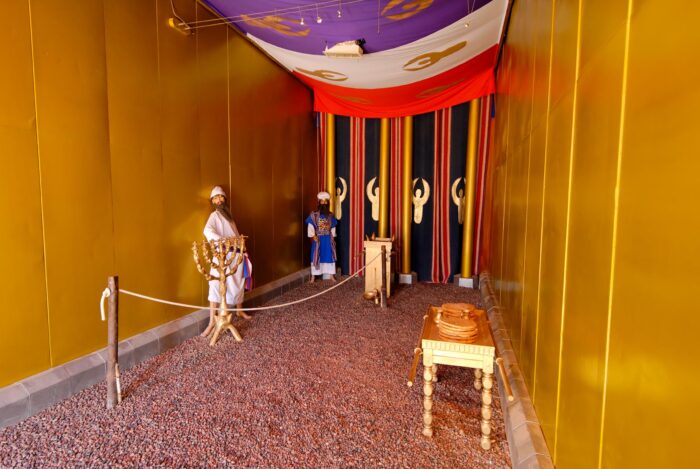
The high priest’s garments (Exodus 28:6) were of “fine linen,” cloth woven so finely that it cannot be distinguished from silk without the aid of magnification. (7) The robes of the Hebrew priests (1) consisted of four linen garments, in addition to which the high priest (1) wore garments made from other materials (Exodus 28, 39; Leviticus 6:10;16:4; 1 Samuel 22:18; Ezekiel 44:17, 18). (11) This is, according to Ezekiel 44:17,18 was prescribed for the coolness of the material that prevented the wearer from sweating which was forbidden for those in temple service. The high priest used a woolen ephod, but was draped only in linen on the great Day of Atonement (Leviticus 16:4, 23). (8)
One of the the New Covenant counterparts to the high priestly linen is presented consistently—even emphatically—in all four Gospels: the linen cloths used by Joseph of Arimathea to wrap Christ’s body for burial. Hebrews 7 and Hebrews 8 establish the doctrinal framework for this identification of Christ as humanity’s perfect and permanent high priest. (6)
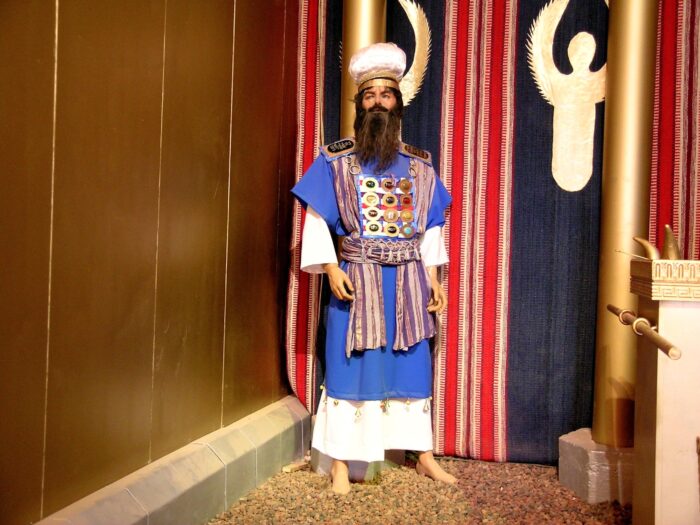
Items to be made of fine linen included: the tabernacle curtains (Exodus 26:1); the veil (Exodus 26:31); the screen (Exodus 26:36); the court hangings (Exodus 27:9); and the priestly garments, which included the ephod (Exodus 28:6), the girdle (Exodus 28:8), the breastpiece of judgment (Exodus 28:15), the coat and turban (Exodus 28:39), and the breeches (Exodus 28:42).
Again, garments made of linen and wool (“two different materials”) were prohibited (Leviticus 19:19; Deuteronomy 22:11; Ezekiel 44:17–18). (5) However, the one exception was the High Priest’s Ephod (1) that was made of gold metal thread along with blue, purple, and scarlet wool yarn and fine twisted linen. (Exodus 28:6).
In religious services by other than priests, white linen was also preferred, as in the case of the infant Samuel who wore an ephod (’ēp̱ôḏ) of linen(1 Samuel 2:18), the Levite singers in the temple (2 Chronicles 5:12), and even royal personages (2 Samuel 6:14; 1 Chronicles 15:27). Accordingly, it was ascribed to angels (Ezekiel 9:2,3,11;10:2,6,7. Daniel 10:5;12:6,7). Fine linen, white and pure, is the raiment assigned to the armies which are in heaven following Him who is called Faithful and True (Revelation 19:14). It is deemed a fitting symbol of the righteousness and purity of the saints (Revelation 19:8). (11)
David danced in front of the ark draped in a linen ephod (2 Samuel 6:14). It seems as if the use of linen was associated with special, holy persons (e.g., the man with the writing-case in Ezekiel. 9:2 and the man Daniel saw in Daniel 10:5;12:6,7). Linen and fine linen were regarded as precious gifts to the woman a man loved. In Ezekiel 16:10,13 the Lord speaks to Jerusalem as a husband to his wife and reminds her how he has decked her with linen and fine linen. It is obvious from Proverbs 31:22 that the use of linen by women was highly esteemed (as in *embroidery). It was a luxury (Isiaih 3:23). The word bûṣ, ‘linen’, is used in the later books as the material for the rich and important people (e.g., Mordecai went to the Persian king draped with a mantle of fine linen (Esther 8:15)). Linen was commonly used for fine furnishings, sails and for protection of precious carpets. (8)
Shrouds
From excavations of royal tombs in Egypt, we know that linen was used to wrap mummies in bandages sometimes hundreds of yards long. (10) Extant pieces of linen from royal Egyptian burials also testify to its superior quality. (5) Many Egyptian mummies now in museums are still wrapped in this fashion, although the linen has faded into a brownish or tan color. (2) Wool was avoided, the belief being that it tended to breed worms. (15)
Likewise, the Hebrews seem to have preferred this material for winding-sheets for the dead, at least in the days of the New Covenant. (11) This practice very likely influenced Jewish burial traditions (John 19:39). As a part of their burial customs, the Jews tore large linen sheets into strips and wrapped perfume inside them close to the body. Even centuries earlier, the Egyptians had wrapped their dead in the same way. (2)
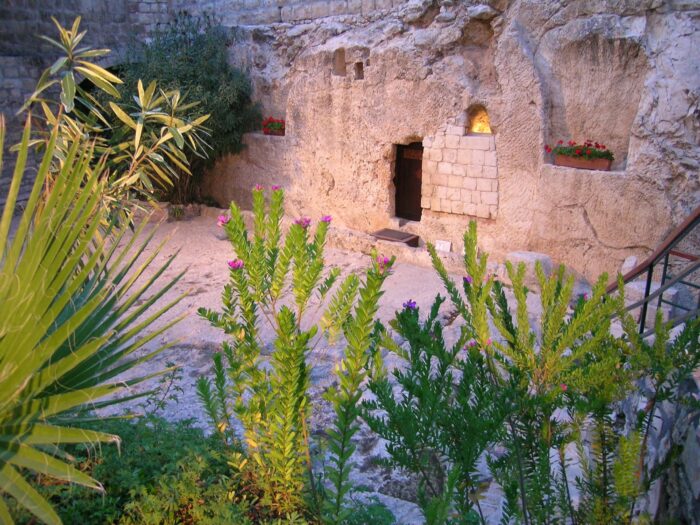
All four of the Gospels note that Jesus’ burial cloth was linen. Linen seems to have been the typical burial cloth, since John 11:44 describes Lazarus as being clothed in “linen strips” when Jesus raises him from the dead. (3)
Joseph took the body, wrapped it in a clean linen cloth, and placed it in his own new tomb that he had cut in the rock. Then he rolled a great stone across the entrance of the tomb and went away.(Matthew 27:59,60 NET)
After Joseph bought a linen cloth and took down the body, he wrapped it in the linen and placed it in a tomb cut out of the rock. Then he rolled a stone across the entrance of the tomb. (Mark 15:46 NET)
Then he took it down, wrapped it in a linen cloth, and placed it in a tomb cut out of the rock, where no one had yet been buried. (Luke 23:53 NET)
Then they took Jesus’ body and wrapped it, with the aromatic spices, in strips of linen cloth according to Jewish burial customs. Now at the place where Jesus was crucified there was a garden, and in the garden was a new tomb where no one had yet been buried. And so, because it was the Jewish day of preparation and the tomb was nearby, they placed Jesus’ body there. (John 19:40-42 NET)
Both of them were running together, but the other disciple outran Peter and reached the tomb first. And stooping to look in, he saw the linen cloths lying there, but he did not go in. Then Simon Peter came, following him, and went into the tomb. He saw the linen cloths lying there, and the face cloth, which had been on Jesus’ head, not lying with the linen cloths but folded up in a place by itself. (John 20:4–7 ESV)
Consider a hot afternoon in Galilee. Can you imagine Jesus completing the final pieces of a job He has worked on for several days? Can you visualize the Lord’s strong carpenter’s forearm, covered with sawdust and sweat — face shiny with heat — as He takes a welcomed drink of cool water. Can you picture Jesus standing to the side of His work, pouring water over His face and chest, splashing it over His arms to clean Himself? Reaching for a nearby towel, patting His face and arms dry? (17)
During Jesus’ time there was one way a carpenter let the contractor know a job was finished— a signature, so to speak. – Sigmund Brouwer
Then, in the carpenter’s tradition, Jesus folds the towel neatly in half, and then He folds it in half again, laying it on the finished work as He walks away. Whoever inspected understood the simple message of the carpenter’s folded towel — the work is finished. (17)
Is it logical to assume that perhaps the Lord’s disciples were aware of this common carpenter’s tradition? If so, then is it at least possible that on that Sunday of sorrow, three and a half years after Jesus had set aside His carpenter’s tools, Peter understood the meaning of the cloth that had covered Jesus’ face—folded neatly there in the empty tomb? Could it be that our Savior left behind an expression of God’s eternal love in the simple message of His earthly profession — the carpenter’s cloth in the linen that covered His face “folded up in a place by itself?” (17)
It is finished!
Typology
The Bible links linen to wealth or honor (Genesis 41:42; Esther 8:15; Proverbs 31:13; Ezekiel 16:10; 27:7; Luke 16:19; Revelation 18:12, 16). Linen is also connected to the holiness of God, of God’s dwelling place, and of those associated with Him (Exodus 26:1; 28:4–6; Leviticus 16:4; Ezekiel 10:1; Daniel 12:7; Revelation 15:6; 19:8, 14). (3)
The association of linen with earthly honor and power becomes apparent in the many Old Covenant references linking it to kings and prosperous nations. The Egyptian Pharaoh and the Persian Ahasuerus clothe Joseph and Mordecai, respectively, in fine linen to honor them for great service to the crown (Genesis 41:42; Esther 8:15). The virtuous woman of Proverbs 31 wears and sells fine linen. Ezekiel records God’s lament that he wrapped Jerusalem with fine linen and silk (Ezekiel 16:10–13) and that the prosperous city of Tyre’s sail of “fine embroidered linen from Egypt … became [her] distinguishing mark” (Ezekiel 27:7). In the NT, the rich but damned Dives (Latin for rich) wears fine linen, as does the nation Babylon (Luke 16:19; Revelation 18:12, 16). Thus linen in the Bible is a “power fabric,” an unequivocal sign of earthly success to persons and nations of the ancient world. (6)
Fine white linen is in Scripture the emblem of innocence or moral purity (Revelation 15:6; 19:8) (16); Pure and white, of righteousness, Revelation 15:6; 19:8, 14 (13); a mark of luxury (Luke 16:19 (12)
In conclusion, linen in the Bible speaks of status:
- To humans, linen symbolizes power, wealth, honor and success.
- To God, linen reflects his holiness, purchased for humans by Christ and to be worn by the church when she weds Christ, to dwell for eternity in his glory. (6)
Biblical Typologies, Metaphors, & Similes Series:
- The Old Leaven of the Kingdom of Darkness
- The New Leaven of the Kingdom of Heaven
- Wine
- Water
- Finely Sifted (Wheat) Flour
- Frankincense
- Myrrh
- Anointing Oil
- Olive Oil
- Honey
- Salt
- Waving and Heaving
- Barley
- Gold
- Silver
- Bronze
- Stone
- Wood
- Linen
- Iron
- Shofar and Trumpet
Shalom
(Security, Wholeness, Success)
Peace
Then he said to them, “Therefore every expert in the law who has been trained for the kingdom of heaven is like the owner of a house who brings out of his treasure what is new and old.” (Matthew 13:52 NET)
(1) Select the link to open another article with additional information in a new tab.
(2) Ronald F. Youngblood, F. F. Bruce, and R. K. Harrison, Thomas Nelson Publishers, eds., Nelson’s New Illustrated Bible Dictionary (Nashville, TN: Thomas Nelson, Inc., 1995).
(3) Coleman Ford, “Linen,” ed. John D. Barry et al., The Lexham Bible Dictionary (Bellingham, WA: Lexham Press, 2016).
(4) D. Irvin, “Linen; Fine Linen; Linen Garment,” ed. Geoffrey W Bromiley, The International Standard Bible Encyclopedia, Revised (Wm. B. Eerdmans, 1979–1988), 139–140.
(5) Susan Rattray, “Linen,” ed. Mark Allan Powell, The HarperCollins Bible Dictionary (Revised and Updated) (New York: HarperCollins, 2011), 560.
(6) Leland Ryken et al., Dictionary of Biblical Imagery (Downers Grove, IL: InterVarsity Press, 2000), 513.
(7) Chad Brand et al., eds., “Linen,” Holman Illustrated Bible Dictionary (Nashville, TN: Holman Bible Publishers, 2003), 1041.
(8) F. C. Fensham, “Linen,” ed. D. R. W. Wood et al., New Bible Dictionary (Leicester, England; Downers Grove, IL: InterVarsity Press, 1996), 691–692.
(9) Mary Petrina Boyd, “Flax, Linen,” ed. David Noel Freedman, Allen C. Myers, and Astrid B. Beck, Eerdmans Dictionary of the Bible (Grand Rapids, MI: W.B. Eerdmans, 2000), 463–464.
(10) Paul J. Achtemeier, Harper & Row and Society of Biblical Literature, Harper’s Bible Dictionary (San Francisco: Harper & Row, 1985), 562.
(11) Ella Davis Isaacs, “Linen,” ed. James Orr et al., The International Standard Bible Encyclopaedia (Chicago: The Howard-Severance Company, 1915), 1894.
(12) Philip Schaff, ed., A Dictionary of the Bible: Including Biography, Natural History, Geography, Topography, Archæology, and Literature (Philadelphia; New York; Chicago: American Sunday-School Union, 1880), 521.
(13) James Swanson and Orville Nave, New Nave’s Topical Bible (Oak Harbor: Logos Research Systems, 1994).
(14) “Linen,” Compton’s Encyclopedia (Chicago, IL: Compton’s Encyclopedia, 2015).
(15) W. Ewing, “Linen,” ed. James Hastings, A Dictionary of Christ and the Gospels: Aaron–Zion (Edinburgh; New York: T&T Clark; Charles Scribner’s Sons, 1906), 35.
(16) Thomas J. Shepherd, The Westminster Bible Dictionary (Philadelphia: Presbyterian Board of Publication, 1880), 319.
(17) Sigmund Brouwer, February 10th 1998 by Thomas Nelson The Carpenter’s Cloth: Christ’s Journey to the Cross and Beyond, ISBN10: 0849953669 (ISBN13: 9780849953668)
(18) Pictures of Israel from: Bolen, T. Pictorial Library of Bible Lands, Israel Collection, Volumes 1-5 Purchased from https://www.bibleplaces.com and used with permission.
(19) Preparation of Flax. (From the Egyptian Monuments. After Wilkinson.
Philip Schaff, ed., A Dictionary of the Bible: Including Biography, Natural History, Geography, Topography, Archæology, and Literature (Philadelphia; New York; Chicago: American Sunday-School Union, 1880), 309.
(20) John Hutton Balfour, The Plants of the Bible (London; Edinburgh; New York: T. Nelson and Sons, 1885), 153.




